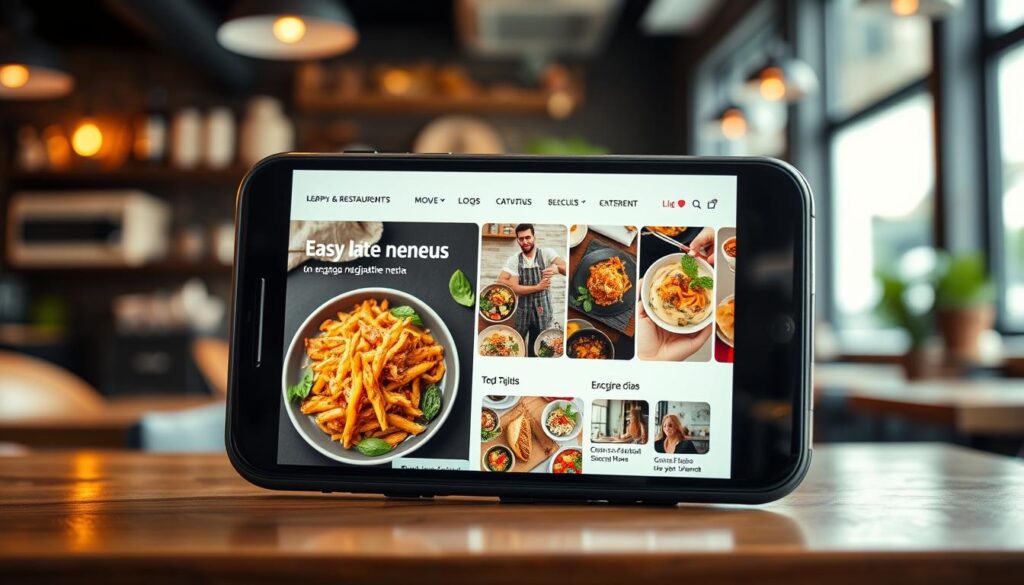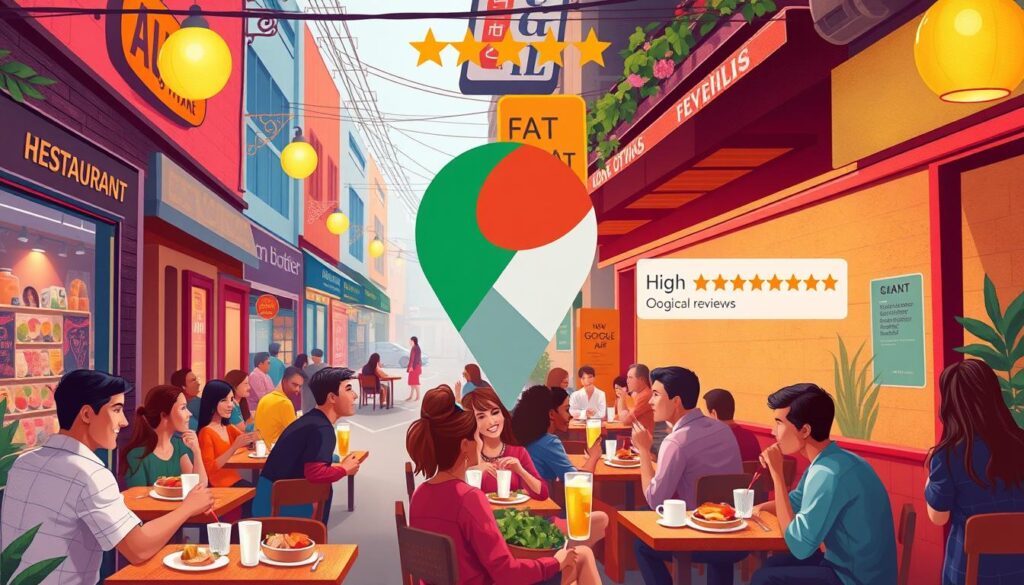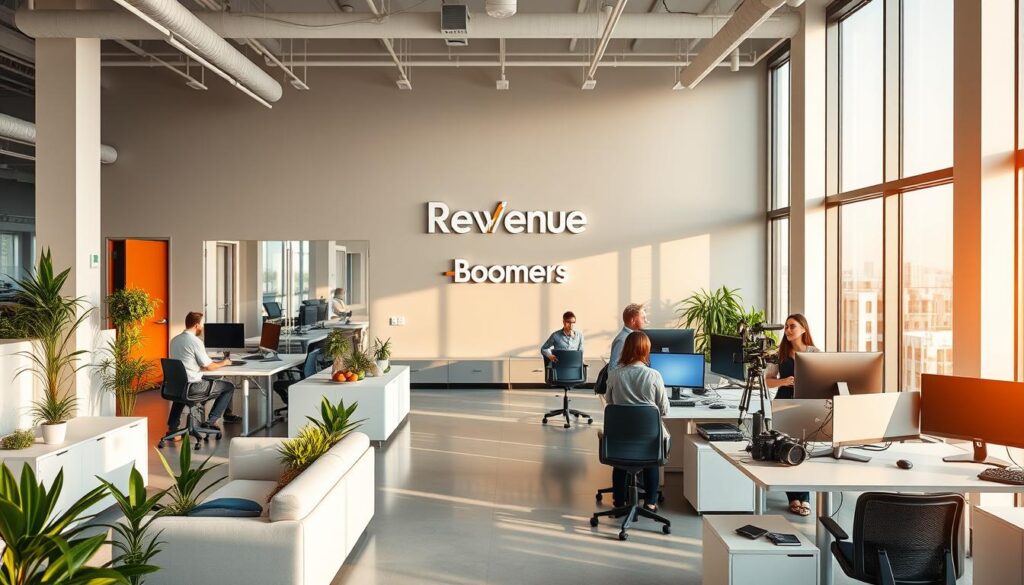Ever wondered why some restaurants pop up first in your Google searches? Others seem to vanish. The world of restaurant SEO is complex but vital for success. With Google handling 97% of all searches, mastering local SEO is key to drawing in customers and boosting sales.
To rank your restaurant on Google, you need a few key steps. First, optimize your Google Business Profile. Then, keep your business info up to date. Lastly, use smart online marketing. These steps can make your restaurant more visible and help you stand out.
We’ll explore the main factors that affect local search rankings. We’ll start with optimizing your Google Business Profile. With the right strategies, you can attract more customers and grow your restaurant’s success.
Key Takeaways
- Understanding local SEO is essential for restaurant visibility on Google.
- Your Google Business Profile must be claimed and optimized for the best results.
- Accurate and engaging business information improves search ranking and customer trust.
- Utilizing schema markup can enhance your restaurant’s online presence.
- Responding to customer reviews can positively influence your restaurant’s reputation.
Understanding the Importance of Local SEO for Restaurants
In a competitive world, local SEO is key for restaurants to draw in local customers. With over 750,000 restaurants in the U.S., being found online can greatly increase visits. By using local SEO, your restaurant can connect with people looking to eat nearby.
Why Local SEO Matters for Your Restaurant
Local SEO is vital for restaurants to show up in online searches. About 46% of Google searches are for local info. This shows how important it is to use local SEO to get noticed.
Being in the “3-pack” on Google Maps can really boost new customers. A detailed Google Business Profile with the right info is crucial. It helps make a good first impression.
Key Components of Local SEO
Good local SEO includes several key parts. Focus on:
- Google Business Profile Optimization: Make sure your profile is full and current. This can help more people find you.
- Consistency of Information: Keep your details the same everywhere. This helps your SEO ranking.
- Online Reviews: Get customers to leave reviews. This can make you look better and attract more people. Almost 55% of customers check at least four reviews before going.
- Local Mentions: Being involved in local events and working with nearby businesses can help. Being in local media or getting local links can also boost your SEO.
Using local SEO can not only improve your ranking but also your reputation. For more tips on local SEO for restaurants, read this in-depth article.
How Do I Rank My Restaurant On Google?
To rank your restaurant on Google, start by optimizing your Google Business Profile. Make sure all business info is correct and up to date. This includes the name, address, phone number, and hours of operation.
A verified and complete profile helps your restaurant show up in search results. It also increases the chance of attracting new customers.
Optimizing Your Google Business Profile
A detailed business profile can help your restaurant rank higher. Google likes profiles that are well-kept. So, make sure to claim your profile and fill it with important info.
Keeping your profile updated is key. It not only helps with Google business listing optimization but also boosts local SEO.
Importance of Accurate Business Information
Having accurate business info is key to building trust. If your details are different on different sites, it can hurt your reputation. This can make it harder for your restaurant to rank well.
Studies show that 68% of people choose new restaurants based on good online reviews. Keeping your NAP (name, address, phone number) the same everywhere shows you’re reliable. This can help improve your ranking.
Updating your Google My Business profile regularly can also help. Since 88% of people decide where to eat on the same day, being visible is crucial. For more tips on improving your restaurant’s SEO, check out this guide.
Spending time on your profile and info can make your restaurant easier to find. This can help more customers choose your place to eat.
The Role of Your Restaurant Website in Google Rankings
A good restaurant website is key to attracting customers and improving your Google ranking. It shows important info and boosts customer interaction. Adding key features can really help your site rank better. Your website should be appealing and meet diners’ needs.
Essential Features Your Website Must Have
To make your restaurant’s site better, consider these features:
- Up-to-Date Menus: Show current menus, as 75% of customers check them before dining.
- High-Quality Images: Use enticing images of your dishes and restaurant to attract visitors.
- Contact Information: Ensure phone numbers, addresses, and hours are easy to find.
- Reservation Links: Use reservation systems that customers like for easy booking.
- Online Ordering: An online ordering system can increase revenue by 130%.
- Virtual Tours: A virtual tour can double reservation bookings, making customers more interested.
Making Your Website Mobile-Friendly
Having a mobile-friendly website is very important. Over 90% of internet users use mobile devices. A mobile-friendly site keeps visitors longer and improves their experience. Think about these points:
- Responsive Design: Use a design that works well on all screen sizes.
- Fast Loading Times: Quick loading times help keep visitors from leaving.
- Simple Navigation: Make it easy for visitors to find what they need.

A well-optimized, mobile-friendly website boosts user experience and local search visibility. A good online presence helps your restaurant stand out in local searches, drawing more diners.
| Feature | Importance |
|---|---|
| Up-to-Date Menus | Crucial for customer decision-making; 75% of diners check menus online. |
| High-Quality Images | Enhances engagement through appealing visuals of food and ambiance. |
| Mobile-Friendly Design | Over 90% of users prefer browsing on mobile devices; critical for visitor retention. |
| Online Ordering | Can increase revenue by 130% compared to those without the service. |
| Reservation Links | Facilitates customer bookings directly through the website. |
Strategies for Google Maps Ranking for Restaurants
To boost your restaurant’s Google Maps ranking, use specific strategies for local targeting. This can greatly improve your visibility. Since local searches meet immediate needs, it’s key to match your online presence with local intent.
Geographic Targeting for Local Searches
By focusing on local targeting, restaurants can stand out in local searches. With 46% of Google searches having local intent, optimizing your Google Business Profile with local keywords is smart. Adding terms like cuisine types, menu items, and neighborhoods boosts your appeal and attracts more diners.
Keeping your business details up-to-date, like hours and location, is crucial. It helps keep you visible in search results.
Using Relevant Keywords in Your Google Business Profile
Adding the right keywords to your Google Business Profile is key for better rankings. Studies show 84% of consumers find businesses through keyword searches, not just names. This shows the value of a strong local marketing strategy with precise keywords.
A detailed and well-optimized listing increases your chances of being in the top three Google Maps results. These results also show up in regular Google Search results.

For more detailed strategies, check out this resource. Focusing on local SEO and Google Maps ranking can bring more traffic and positive customer interactions through better online visibility.
Effective Online Reputation Management for Restaurants
In the competitive restaurant world, managing your online reputation is key. It helps attract and keep customers. With 90% of people checking online before dining out, a good online image is crucial. This part talks about how to handle customer reviews and get more positive feedback.
Responding to Customer Reviews
It’s important to engage with what customers say online. Saying thanks for both good and bad reviews shows you care about what they think. Quick responses are important, as 53% of customers want a reply within a week.
Dealing with negative reviews well can help. It shows you’re serious about making things right. Businesses that respond thoughtfully are more likely to attract new customers.
Encouraging Positive Reviews
Getting customers to share their good experiences can boost your reputation. Offering free treats or drinks can encourage them to write positive reviews. Using different ways to ask for feedback, like receipts or digital kiosks, helps too.
Places like The Hampton Social in Orlando have seen a big jump in Google reviews by asking nicely. Having lots of positive reviews is important. 94% of customers pick restaurants based on what they see online.
Utilizing Restaurant Search Engine Marketing
In the competitive restaurant world, search engine marketing is key for growth. Pay-per-click (PPC) advertising is a powerful tactic. It puts your ads at the top of search results, drawing in potential customers.
This approach boosts your online presence. It also lets you make quick changes based on data to get the most out of your ads.
Pay-Per-Click Advertising Benefits
PPC advertising has many benefits for restaurants. It offers fast exposure, unlike organic search results which take time. It also lets you link directly to menus or special offers.
This increases the chance of turning searches into actual visits. It works well when paired with targeted marketing campaigns.
Creating Targeted Marketing Campaigns
Creating campaigns based on customer behavior is crucial in restaurant SEM. Using data analytics helps you understand your audience better. This way, you can make messages and promotions that really speak to them.
It drives engagement and loyalty. Using local keywords and tailored content also boosts visibility. This strengthens your organic SEO efforts.






